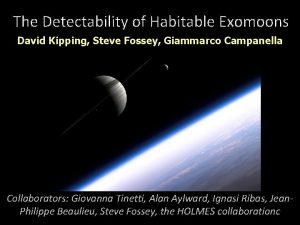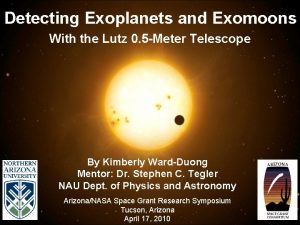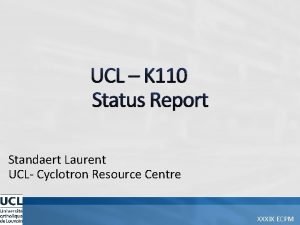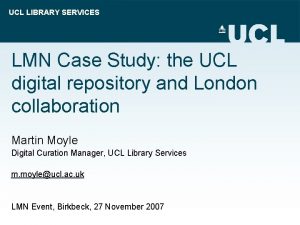The Search for Exomoons David Kipping UCL th













































- Slides: 45

The Search for Exomoons David Kipping, UCL th 23 September 2008 Acknowledgements: Giovanna Tinetti, Alan Aylward, Ignasi Ribas, Jean-Philippe Beaulieu, Steve Fossey, the HOLMES collaboration

Motivation Detection Methods The TDV Effect What is an Exomoon? • A smaller, natural satellite that orbits an extrasolar planet. 2/18 Molecules 2008, D. Kipping

Motivation Detection Methods The TDV Effect What is an Exomoon? • A smaller, natural satellite that orbits an extrasolar planet. • There are no known exomoons, but their existence is theorized around many exoplanets. 2/18 Molecules 2008, D. Kipping

Motivation Detection Methods The TDV Effect What is an Exomoon? • A smaller, natural satellite that orbits an extrasolar planet. • There are no known exomoons, but their existence is theorized around many exoplanets. 2/18 Molecules 2008, D. Kipping

Motivation Detection Methods The TDV Effect Why Look for Exomoons? 1. A novel detection and proof of principle. 3/18 Molecules 2008, D. Kipping

Motivation Detection Methods The TDV Effect Why Look for Exomoons? 1. A novel detection and proof of principle. 3/18 Molecules 2008, D. Kipping

Motivation Current Methods The TDV Effect Why Look for Exomoons? 1. A novel detection and proof of principle. Sartoretti & Schneider 1999 Szabo et al. 2006 Simon et al. 2007 Kipping 2008 3/18 Molecules 2008, D. Kipping

Motivation Detection Methods The TDV Effect Why Look for Exomoons? 1. A novel detection and proof of principle. 2. Exomoons are likely to be < MEARTH and rocky. 3/18 Molecules 2008, D. Kipping

Motivation Detection Methods The TDV Effect Why Look for Exomoons? 1. A novel detection and proof of principle. 2. Exomoons are likely to be < MEARTH and rocky. Belbruno & Gott 2005 Valencia et al. 2006 Canup & Ward 2007 3/18 Molecules 2008, D. Kipping

Motivation Detection Methods The TDV Effect Why Look for Exomoons? 1. A novel detection and proof of principle. 2. Exomoons are likely to be < MEARTH and rocky. 3. Complex life may not form on exoplanets without large moons. 3/18 Molecules 2008, D. Kipping

Motivation Detection Methods The TDV Effect Why Look for Exomoons? 1. A novel detection and proof of principle. 2. Exomoons are likely to be < MEARTH and rocky. 3. Complex life may not form on exoplanets without large moons. 3/18 Molecules 2008, D. Kipping

Motivation Detection Methods The TDV Effect Why Look for Exomoons? 1. A novel detection and proof of principle. 2. Exomoons are likely to be < MEARTH and rocky. 3. Complex life may not form on exoplanets without large moons. Laskar et al. 1993 Ward & Brownlee 2000 Waltham 2004 Lathe 2005 3/18 Molecules 2008, D. Kipping

Motivation Detection Methods The TDV Effect Why Look for Exomoons? 1. A novel detection. 2. Exomoons are likely to be < MEARTH. 3. Complex life may not form on exoplanets without large moons. 4. There may be more habitable exomoons than exoplanets. 3/18 Molecules 2008, D. Kipping

Motivation Detection Methods The TDV Effect Why Look for Exomoons? 1. A novel detection. 2. Exomoons are likely to be < MEARTH. 3. Complex life may not form on exoplanets without large moons. 4. There may be more habitable exomoons than exoplanets. 3/18 Molecules 2008, D. Kipping

Motivation Detection Methods The TDV Effect Why Look for Exomoons? 1. A novel detection. 2. Exomoons are likely to be < MEARTH. 3. Complex life may not form on exoplanets without large moons. 4. There may be more habitable exomoons than exoplanets. Scharf 2008 3/18 Thommes et al. 2008 Molecules 2008, D. Kipping

Motivation Detection Methods The TDV Effect Why Look for Exomoons? 1. A novel detection. 2. Exomoons are likely to be < MEARTH. 3. Complex life may not form on exoplanets without large moons. 4. There may be more habitable exomoons than exoplanets. 5. Implications for planetary formation theory. 3/18 Molecules 2008, D. Kipping

Motivation Detection Methods The TDV Effect Direct Imaging? • • • 4/18 Brightness ratio 1: 1010. An Earth-sized body 0. 02 micro arcseconds. Current interferometric precision 25 micro arcseconds (Baines et al. 2007) Molecules 2008, D. Kipping

Motivation Detection Methods The TDV Effect Direct Imaging? • • • Brightness ratio 1: 1010. An Earth-sized body 0. 02 micro arcseconds. Current interferometric precision 25 micro arcseconds (Baines et al. 2007) NWO Proposal 4/18 Molecules 2008, D. Kipping

Motivation Detection Methods The TDV Effect Direct Imaging? • • Brightness ratio 1: 1010. An Earth-sized body 0. 02 micro arcseconds. Current interferometric precision 25 micro arcseconds (Baines et al. 2007) => Directly imaging an exomoon is currently impossible. NWO Proposal 4/18 Molecules 2008, D. Kipping

Motivation Detection Methods The TDV Effect Radial Velocity? • • 5/18 Radial velocity (Doppler spectroscopy) measures the wobble of the host star due to a planet. This method would be insensitive to a planet + moon system. Molecules 2008, D. Kipping

Motivation Detection Methods The TDV Effect Radial Velocity? • • 5/18 Radial velocity (Doppler spectroscopy) measures the wobble of the host star due to a planet. This method would be insensitive to a planet + moon system. Molecules 2008, D. Kipping

Motivation Detection Methods The TDV Effect Radial Velocity? • • • 5/18 Radial velocity (Doppler spectroscopy) measures the wobble of the host star due to a planet. This method would be insensitive to a planet + moon system. => Radial velocity cannot be used to detect exomoons. Molecules 2008, D. Kipping

Motivation Detection Methods The TDV Effect Occultation? • 6/18 Could we look for the dip in star light due to an exomoon’s shadow? Molecules 2008, D. Kipping

Motivation Detection Methods The TDV Effect The Transit Method 7/18 Winn et al. 2008 Molecules 2008, D. Kipping

Motivation Detection Methods The TDV Effect Occultation? • Planet transit + Exomoon transit Simon et al. 2007 8/18 Molecules 2008, D. Kipping

Motivation Detection Methods The TDV Effect Occultation? • • Problem 1: Transit of moon is very small. Require space-based telescope to do 2. 5 MEARTH. Ballard et al. 2008 8/18 Molecules 2008, D. Kipping

Motivation Detection Methods The TDV Effect Occultation? • Problem 2: Average position of moon results in lightcurves overlapping: indistinguishable. Cabrera & Schneider 2005 8/18 Molecules 2008, D. Kipping

Motivation Detection Methods The TDV Effect Occultation? • • 9/18 Could we look for the dip in star light due to an exomoon’s shadow? => Possible, but somewhat insensitive to low mass objects. Molecules 2008, D. Kipping

Motivation 10/18 Detection Methods The TDV Effect Molecules 2008, D. Kipping

Motivation 11/18 Detection Methods The TDV Effect Molecules 2008, D. Kipping

Motivation 12/18 Detection Methods The TDV Effect Molecules 2008, D. Kipping

Motivation Detection Methods The TDV Effect Transit Time Variation (TTV) 13/18 Molecules 2008, D. Kipping

Motivation Detection Methods The TDV Effect Transit Time Variation (TTV) 13/18 Molecules 2008, D. Kipping

Motivation Detection Methods The TDV Effect Transit Time Variation (TTV) 13/18 Molecules 2008, D. Kipping

Motivation Detection Methods The TDV Effect Transit Time Variation (TTV) 13/18 Molecules 2008, D. Kipping

Motivation Detection Methods The TDV Effect The Problem with TTV • • 14/18 Lots of things can cause TTV, not just exomoons. Prof. Holman called this the ‘inverse-problem’. Molecules 2008, D. Kipping

Motivation Detection Methods The TDV Effect The Problem with TTV • • 14/18 Lots of things can cause TTV, not just exomoons. Prof. Holman called this the ‘inverse-problem’. TTV MMOON a. MOON 1 measureable, 2 unknowns => Can’t solve! Molecules 2008, D. Kipping

Motivation Detection Methods The TDV Effect The Transit Method (7/18) Molecules 2008, D. Kipping

Motivation (12/18) Detection Methods The TDV Effect Molecules 2008, D. Kipping

Motivation Detection Methods The TDV Effect Transit Duration Variation (TDV) 15/18 Molecules 2008, D. Kipping

Motivation Detection Methods The TDV Effect Transit Duration Variation (TDV) 15/18 Molecules 2008, D. Kipping

Motivation Detection Methods The TDV Effect Transit Duration Variation (TDV) 15/18 Molecules 2008, D. Kipping

Motivation Detection Methods The TDV Effect TTV + TDV = A Unique Signature • • • 16/18 The TDV signals lags behind the TTV signal by 90 o. TTV TDV 1 -10 seconds. TTV and TDV allow you to solve for both the mass and orbital radius of the exomoon. Molecules 2008, D. Kipping

Motivation Detection Methods The TDV Effect Sensitivity • 17/18 An Earth mass exomoon is detectable from the ground with current instruments! Molecules 2008, D. Kipping

Motivation Detection Methods The TDV Effect The Holy Grail of Exomoons • • • 18/18 Consider a Neptune –like planet around an M-dwarf on a 35 -day period => Goldilocks zone. Consider an Earth mass exomoon orbiting this planet. TTV 140 s and TDV 60 s. Typical TTV error 10 s Typical TDV error 20 s. => Very secure detection of a habitable Earth-like body! Molecules 2008, D. Kipping
 Prof david kipping
Prof david kipping Mark kipping
Mark kipping David bogle
David bogle Fspos vägledning för kontinuitetshantering
Fspos vägledning för kontinuitetshantering Typiska novell drag
Typiska novell drag Tack för att ni lyssnade bild
Tack för att ni lyssnade bild Ekologiskt fotavtryck
Ekologiskt fotavtryck Shingelfrisyren
Shingelfrisyren En lathund för arbete med kontinuitetshantering
En lathund för arbete med kontinuitetshantering Kassaregister ideell förening
Kassaregister ideell förening Personlig tidbok för yrkesförare
Personlig tidbok för yrkesförare Anatomi organ reproduksi
Anatomi organ reproduksi Densitet vatten
Densitet vatten Datorkunskap för nybörjare
Datorkunskap för nybörjare Tack för att ni lyssnade bild
Tack för att ni lyssnade bild Att skriva debattartikel
Att skriva debattartikel Delegerande ledarskap
Delegerande ledarskap Nyckelkompetenser för livslångt lärande
Nyckelkompetenser för livslångt lärande Påbyggnader för flakfordon
Påbyggnader för flakfordon Tryck formel
Tryck formel Svenskt ramverk för digital samverkan
Svenskt ramverk för digital samverkan Jag har nigit för nymånens skära
Jag har nigit för nymånens skära Presentera för publik crossboss
Presentera för publik crossboss Jiddisch
Jiddisch Vem räknas som jude
Vem räknas som jude Klassificeringsstruktur för kommunala verksamheter
Klassificeringsstruktur för kommunala verksamheter Mjälthilus
Mjälthilus Bästa kameran för astrofoto
Bästa kameran för astrofoto Cks
Cks Programskede byggprocessen
Programskede byggprocessen Bra mat för unga idrottare
Bra mat för unga idrottare Verktyg för automatisering av utbetalningar
Verktyg för automatisering av utbetalningar Rutin för avvikelsehantering
Rutin för avvikelsehantering Smärtskolan kunskap för livet
Smärtskolan kunskap för livet Ministerstyre för och nackdelar
Ministerstyre för och nackdelar Tack för att ni har lyssnat
Tack för att ni har lyssnat Vad är referatmarkeringar
Vad är referatmarkeringar Redogör för vad psykologi är
Redogör för vad psykologi är Matematisk modellering eksempel
Matematisk modellering eksempel Tack för att ni har lyssnat
Tack för att ni har lyssnat Borra hål för knoppar
Borra hål för knoppar Orubbliga rättigheter
Orubbliga rättigheter Formula varians
Formula varians Tack för att ni har lyssnat
Tack för att ni har lyssnat Rita perspektiv
Rita perspektiv Vad är verksamhetsanalys
Vad är verksamhetsanalys





































































